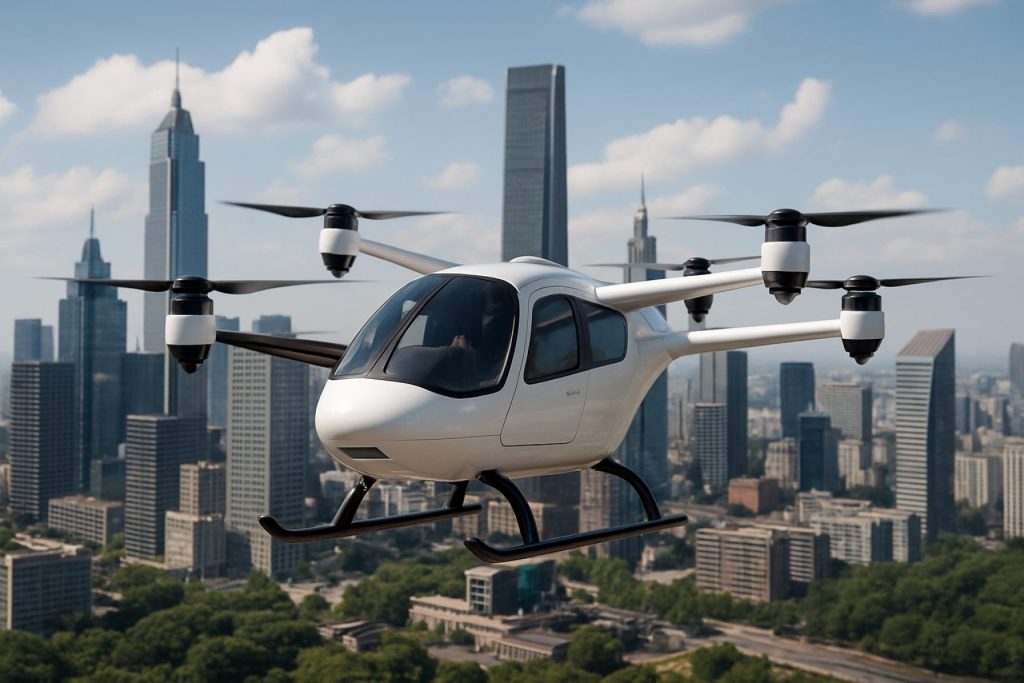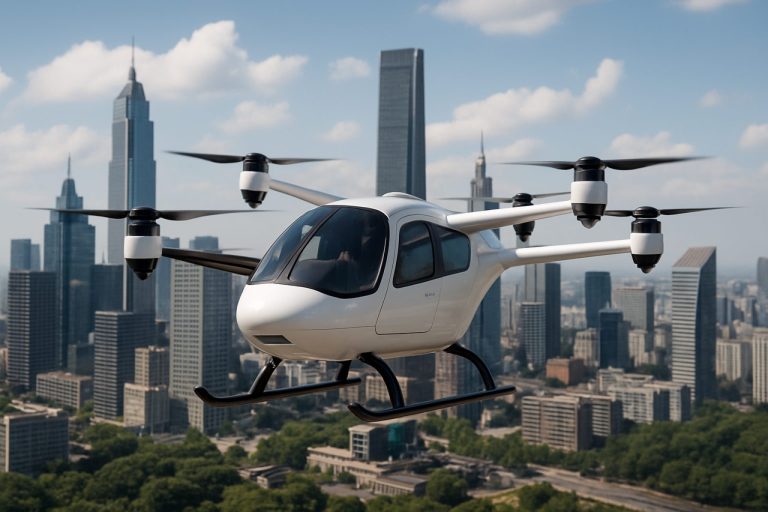
Autonomous Urban Air Passenger Mobility Industry Report 2025: Market Growth, Technology Innovations, and Strategic Insights for the Next 5 Years
- Executive Summary & Market Overview
- Key Technology Trends in Autonomous Urban Air Mobility
- Competitive Landscape: Leading Players & Emerging Entrants
- Market Growth Forecasts (2025–2030): CAGR, Volume, and Value Analysis
- Regional Analysis: North America, Europe, Asia-Pacific, and Rest of World
- Future Outlook: Urban Integration, Policy, and Consumer Adoption
- Challenges and Opportunities: Regulatory, Infrastructure, and Investment Perspectives
- Sources & References
Executive Summary & Market Overview
Autonomous Urban Air Passenger Mobility refers to the deployment of self-piloted aerial vehicles—commonly known as air taxis or eVTOLs (electric vertical takeoff and landing aircraft)—for transporting passengers within urban environments. This emerging sector is positioned at the intersection of advanced aviation, artificial intelligence, and smart city infrastructure, aiming to alleviate ground congestion and redefine urban transportation paradigms.
By 2025, the global market for autonomous urban air passenger mobility is transitioning from conceptual pilots to early-stage commercial operations. Key industry players, including Joby Aviation, Lilium, Volocopter, and Archer Aviation, are advancing towards regulatory certification and initial deployment in select metropolitan areas. According to Morgan Stanley, the global urban air mobility (UAM) market could reach $1 trillion by 2040, with autonomous passenger services representing a significant share as autonomy matures.
In 2025, the market is characterized by:
- Regulatory Progress: Aviation authorities such as the Federal Aviation Administration (FAA) and European Union Aviation Safety Agency (EASA) are actively developing certification frameworks for autonomous eVTOLs, with pilot programs underway in the U.S., Europe, and Asia.
- Technological Advancements: Improvements in battery energy density, lightweight composite materials, and AI-driven flight control systems are accelerating the readiness of autonomous air taxis for urban deployment.
- Urban Integration: Partnerships between eVTOL manufacturers, city planners, and infrastructure providers (e.g., Urban-Air Port) are facilitating the development of vertiports and digital air traffic management systems.
- Investment Momentum: The sector continues to attract significant venture capital and strategic investments, with over $7 billion raised by leading eVTOL companies as of 2024 (Crunchbase).
Despite these advances, the market faces challenges including regulatory uncertainty, public acceptance, airspace integration, and the need for robust safety validation. Nevertheless, 2025 is expected to mark a pivotal year, with the first limited commercial autonomous passenger flights anticipated in cities such as Los Angeles, Dubai, and Singapore (NASA). The sector’s trajectory suggests a transformative impact on urban mobility, with scalability hinging on continued technological, regulatory, and societal progress.
Key Technology Trends in Autonomous Urban Air Mobility
Autonomous Urban Air Passenger Mobility (AUAPM) is rapidly evolving, driven by advances in artificial intelligence, sensor fusion, connectivity, and electric propulsion. As of 2025, several key technology trends are shaping the sector, with leading aerospace and technology companies accelerating development and deployment of urban air mobility (UAM) solutions.
- Advanced Autonomy and AI: The integration of sophisticated AI algorithms enables real-time decision-making, obstacle avoidance, and adaptive flight path planning. Companies like Airbus and Boeing are investing in machine learning systems that allow air taxis to operate with minimal human intervention, enhancing safety and scalability.
- Sensor Fusion and Redundancy: AUAPM vehicles now employ multi-modal sensor suites—combining LiDAR, radar, cameras, and ultrasonic sensors—to achieve robust situational awareness. This redundancy is critical for safe navigation in complex urban environments, as demonstrated by Volocopter and Joby Aviation in their latest prototypes.
- Electric Propulsion and Battery Innovation: The shift to distributed electric propulsion systems is reducing noise and emissions, a necessity for urban deployment. Battery energy density improvements, led by partnerships between aviation and battery manufacturers, are extending range and payload capabilities. Lilium and EHang are notable for their focus on high-performance battery integration.
- Vehicle-to-Everything (V2X) Connectivity: Seamless communication between air vehicles, ground infrastructure, and air traffic management systems is being enabled by 5G and edge computing. This connectivity supports dynamic rerouting, fleet coordination, and integration with smart city platforms, as piloted by Hyundai Motor Group and Uber Elevate (now part of Joby Aviation).
- Certification and Digital Twin Simulation: Regulatory bodies and manufacturers are leveraging digital twin technology to simulate and validate autonomous flight operations at scale. This accelerates certification processes and ensures compliance with evolving safety standards, as seen in collaborations between NASA and industry leaders.
These trends collectively indicate that by 2025, AUAPM is transitioning from experimental flights to early-stage commercial operations, with technology readiness and regulatory alignment as primary enablers.
Competitive Landscape: Leading Players & Emerging Entrants
The competitive landscape of autonomous urban air passenger mobility in 2025 is characterized by a dynamic mix of established aerospace giants, innovative startups, and technology conglomerates, all vying for leadership in this nascent but rapidly evolving sector. The market is witnessing significant investments, strategic partnerships, and pilot projects as companies race to commercialize autonomous air taxi services in urban environments.
Leading Players
- Airbus remains a frontrunner with its CityAirbus NextGen program, focusing on fully electric, autonomous vertical takeoff and landing (eVTOL) vehicles. Airbus leverages its aerospace expertise and global infrastructure to conduct test flights and collaborate with urban authorities for regulatory alignment.
- Boeing, through its Boeing NeXt division, is advancing autonomous passenger air vehicles, emphasizing safety, scalability, and integration with existing airspace systems. Boeing’s partnerships with technology firms and urban planners position it as a key player in shaping regulatory frameworks.
- Joby Aviation has emerged as a leader among startups, with its piloted and autonomous eVTOL aircraft achieving significant milestones in flight testing and certification. Backed by major investors and strategic alliances with ride-hailing platforms, Joby is targeting early commercial deployment in select cities.
- Volocopter is advancing its VoloCity air taxi, focusing on autonomous operations and urban integration. The company has conducted public demonstration flights and is working closely with European regulators to secure type certification.
Emerging Entrants
- Lilium is developing a five-seat, fully electric jet with autonomous capabilities, targeting intercity and urban routes. The company’s unique ducted fan design and strong funding base have attracted attention from both investors and city governments.
- EHang, based in China, is pioneering autonomous aerial vehicles (AAVs) and has already launched pilot passenger services in select Asian cities. EHang’s regulatory progress and operational data provide a competitive edge in the global market.
- Wisk Aero, a joint venture between Boeing and Kitty Hawk, is focused exclusively on autonomous, all-electric air taxis. Wisk’s Cora aircraft is undergoing extensive testing, with plans for commercial operations in the U.S. and New Zealand.
As of 2025, the sector is marked by rapid technological advancements, regulatory hurdles, and a race to secure first-mover advantage. Strategic collaborations between aerospace, automotive, and technology firms are accelerating the path to commercialization, while emerging entrants continue to challenge incumbents with disruptive innovations and agile business models.
Market Growth Forecasts (2025–2030): CAGR, Volume, and Value Analysis
The market for autonomous urban air passenger mobility is poised for significant expansion between 2025 and 2030, driven by rapid technological advancements, increasing urban congestion, and supportive regulatory frameworks. According to projections by McKinsey & Company, the global advanced air mobility (AAM) market—which includes autonomous passenger drones and air taxis—is expected to achieve a compound annual growth rate (CAGR) of approximately 25% during this period. This robust growth is underpinned by pilot projects in major metropolitan areas, rising investment from both established aerospace firms and new entrants, and the anticipated commercialization of autonomous eVTOL (electric vertical takeoff and landing) vehicles.
In terms of market value, Morgan Stanley estimates that the urban air mobility sector could reach a global market size of $30–50 billion by 2030, with autonomous passenger services accounting for a substantial share as regulatory approvals accelerate. The volume of autonomous passenger flights is projected to rise sharply, with Roland Berger forecasting over 160,000 commercial air taxis in operation worldwide by 2050, with a significant portion deployed in the 2025–2030 window as pilot programs transition to full-scale operations.
- CAGR (2025–2030): Estimated at 25% for autonomous urban air passenger mobility, outpacing traditional aviation growth rates.
- Market Value (2030): Projected to reach $30–50 billion globally, with North America, Europe, and select Asia-Pacific cities leading adoption.
- Volume: Thousands of autonomous passenger flights per day are expected in major cities by 2030, as per PwC analysis.
Key drivers for this growth include advancements in autonomous flight control, battery technology, and urban infrastructure integration. However, the pace of market expansion will depend on regulatory harmonization, public acceptance, and the scalability of supporting infrastructure. Overall, the 2025–2030 period is set to mark the transition from demonstration projects to the early stages of commercial autonomous urban air passenger services, laying the groundwork for mass adoption in the following decade.
Regional Analysis: North America, Europe, Asia-Pacific, and Rest of World
The regional landscape for autonomous urban air passenger mobility in 2025 is shaped by varying regulatory environments, infrastructure readiness, investment levels, and public acceptance across North America, Europe, Asia-Pacific, and the Rest of World.
- North America: The United States leads the North American market, driven by robust investment in urban air mobility (UAM) startups and supportive regulatory initiatives from the Federal Aviation Administration. Major cities such as Los Angeles and Dallas are piloting advanced air mobility corridors, with companies like Joby Aviation and Aurora Flight Sciences conducting test flights. Canada is also exploring UAM, focusing on integrating autonomous air taxis into existing airspace frameworks. The region benefits from a strong aerospace ecosystem and early adoption of new mobility technologies.
- Europe: Europe’s approach is characterized by coordinated regulatory efforts through the European Union Aviation Safety Agency (EASA) and city-level pilot programs. Germany, France, and the UK are at the forefront, with companies like Volocopter and Lilium advancing commercial deployment plans. European cities emphasize sustainability and integration with public transport, with Paris targeting operational air taxi services for the 2024 Olympics as a showcase for broader adoption in 2025. The region’s regulatory clarity and public-private partnerships are accelerating market readiness.
- Asia-Pacific: The Asia-Pacific region is experiencing rapid growth, led by China, Japan, and South Korea. China’s EHang is conducting large-scale autonomous passenger drone trials, supported by government-backed smart city initiatives. Japan is preparing for commercial launches ahead of the Osaka World Expo 2025, with strong collaboration between the Ministry of Land, Infrastructure, Transport and Tourism and private sector players. South Korea is investing in UAM infrastructure, aiming for commercial operations in Seoul by 2025. The region’s dense urban centers and government support are key growth drivers.
- Rest of World: In the Middle East, the Dubai Roads and Transport Authority is piloting autonomous air taxi services, positioning Dubai as a regional hub for UAM innovation. Latin America and Africa are in earlier stages, focusing on regulatory frameworks and feasibility studies, with some pilot projects in major cities. The pace of adoption in these regions will depend on infrastructure investment and regulatory harmonization.
Overall, 2025 will see North America and Europe leading in regulatory maturity and pilot deployments, while Asia-Pacific emerges as a high-growth market with large-scale trials and early commercialization. The Rest of World region is expected to follow as regulatory and infrastructure barriers are addressed.
Future Outlook: Urban Integration, Policy, and Consumer Adoption
The future outlook for autonomous urban air passenger mobility in 2025 is shaped by the interplay of urban integration, regulatory policy, and consumer adoption. As cities grapple with congestion and sustainability challenges, the integration of autonomous air mobility (AAM) solutions—such as electric vertical takeoff and landing (eVTOL) aircraft—into urban environments is gaining momentum. Urban planners and mobility providers are collaborating to identify optimal vertiport locations, airspace corridors, and multimodal connections to ensure seamless integration with existing transportation networks. For example, European Union Aviation Safety Agency has published vertiport design guidelines, signaling a move toward standardized infrastructure.
Policy frameworks are evolving rapidly to address the unique safety, airspace management, and certification requirements of autonomous passenger drones. In 2025, regulatory bodies such as the Federal Aviation Administration and EASA are expected to advance rulemaking for pilotless operations, remote supervision, and integration with traditional air traffic control. These efforts are critical to unlocking commercial deployments and scaling operations beyond pilot projects. Additionally, public-private partnerships are accelerating the development of urban air mobility (UAM) ecosystems, with cities like Paris and Los Angeles serving as testbeds for early deployment (NASA).
Consumer adoption remains a pivotal factor. Surveys by McKinsey & Company and Deloitte indicate that while public awareness of AAM is rising, concerns about safety, noise, cost, and privacy persist. In 2025, industry leaders are expected to focus on public education campaigns, transparent safety records, and pilot demonstration flights to build trust. Early adopters are likely to be business travelers and high-income commuters, with broader adoption hinging on regulatory clarity and cost reductions.
- Urban integration will depend on robust infrastructure and digital airspace management systems.
- Policy harmonization across jurisdictions is essential for cross-city and international operations.
- Consumer acceptance will be driven by demonstrable safety, affordability, and convenience.
Overall, 2025 is poised to be a pivotal year for autonomous urban air passenger mobility, with significant progress expected in regulatory frameworks, infrastructure deployment, and public engagement, setting the stage for commercial scalability in the latter half of the decade.
Challenges and Opportunities: Regulatory, Infrastructure, and Investment Perspectives
The evolution of autonomous urban air passenger mobility (AUAPM) in 2025 is shaped by a complex interplay of regulatory, infrastructure, and investment factors. Each presents distinct challenges and opportunities that will determine the pace and scale of AUAPM adoption in urban environments.
Regulatory Perspectives: Regulatory frameworks remain a primary hurdle for AUAPM. The integration of autonomous aerial vehicles into urban airspace requires harmonization across national and municipal aviation authorities. In 2025, the European Union Aviation Safety Agency (EASA) and the Federal Aviation Administration (FAA) are advancing certification standards for both vehicles and operators, but the lack of globally unified standards creates uncertainty for manufacturers and operators. Additionally, public acceptance and privacy concerns are prompting regulators to consider new frameworks for noise, safety, and data protection.
Infrastructure Perspectives: Urban air mobility demands significant upgrades to existing infrastructure. The deployment of vertiports, charging stations, and air traffic management systems tailored for low-altitude, high-density operations is essential. In 2025, cities like Paris and Los Angeles are piloting vertiport networks, but scalability remains a challenge due to high capital costs and the need for integration with ground transportation systems (Urban Air Mobility Initiative). Digital infrastructure, such as Unmanned Aircraft System Traffic Management (UTM), is also in early stages, with interoperability and cybersecurity as ongoing concerns.
Investment Perspectives: The AUAPM sector continues to attract significant venture capital and strategic investments. According to Morgan Stanley, the global urban air mobility market could reach $1 trillion by 2040, with autonomous solutions representing a substantial share. However, the capital-intensive nature of vehicle development, certification, and infrastructure buildout means that only well-funded players are likely to survive the initial commercialization phase. Public-private partnerships are emerging as a key model to share risk and accelerate deployment, as seen in collaborations between city governments and companies like Joby Aviation and Volocopter.
In summary, while regulatory uncertainty, infrastructure demands, and high investment thresholds pose significant challenges, they also create opportunities for innovation, cross-sector collaboration, and new business models in the AUAPM ecosystem in 2025.
Sources & References
- Joby Aviation
- Volocopter
- Archer Aviation
- Morgan Stanley
- European Union Aviation Safety Agency (EASA)
- Crunchbase
- NASA
- Airbus
- Boeing
- EHang
- Hyundai Motor Group
- McKinsey & Company
- Roland Berger
- PwC
- Aurora Flight Sciences
- Dubai Roads and Transport Authority
- Deloitte



